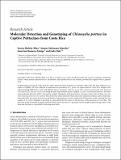| dc.contributor.author | Dolz, Gaby | |
| dc.contributor.author | Sheleby-Elías, Jessica | |
| dc.contributor.author | Solórzano-Morales, Ántony | |
| dc.contributor.author | Romero-Zúñiga, Juan José | |
| dc.date.accessioned | 2020-08-19T20:23:04Z | |
| dc.date.available | 2020-08-19T20:23:04Z | |
| dc.date.issued | 2013-08-18 | |
| dc.identifier.uri | http://hdl.handle.net/11056/17929 | |
| dc.description.abstract | Oropharyngeal and cloacal swabs from 117 captive psittacine birds presented at veterinary clinics (88) and from shelters/rescue centers of wildlife (29) were collected to determine the prevalence of C. psittaci in captive birds in Costa Rica. Samples were collected during 2009 from a total of 19 different species of parrots, with Ara macao (33), Amazona autumnalis (24), Amazona ochrocephala (21), and Ara ararauna (8) being the most representative species sampled. C. psittaci was detected in four (3.4%) birds using molecular detection (PCR). The positive samples belonged to birds presented at veterinary clinics; three of them were Ara macao and one Amazona ochrocephala. Three birds were adults; all positive birds showed no symptoms of illness and lived in homes with other birds, two in San José and two in Heredia. Sequencing was used to confirm the PCR positive results, showing that two samples of C. psittaci belonged to genotype A, representing the first report of the presence of this genotype in Costa Rica. The detection of this bacterium in captive psittacine birds shows that there is a potential risk for people living or having contact with them and that there is a possibility of infecting other birds. | es_ES |
| dc.description.abstract | Se recogieron hisopos orofaríngeos y cloacales de 117 aves psitácidas cautivas presentadas en clínicas veterinarias (88) y de refugios/rescatistas de fauna silvestre (29) para determinar la prevalencia de las aves cautivas de C. psittaciin en Costa Rica. Durante 2009 se recogieron muestras de un total de 19 especies diferentes de loros, siendo Ara macao(33), Amazona autumnalis (24), Amazonaochrocephala(21) y Ara ararauna(8) las especies más representativas de las que se tomaron muestras. Las muestras positivas pertenecían a aves presentadas en clínicas veterinarias; tres de ellas eran Aramacao y una Amazona ochrocephala. Tres aves eran adultas; todas las aves positivas no mostraron síntomas de enfermedad y vivían en hogares con otras aves, dos en San José y dos en Heredia. Se utilizó la secuenciación para confirmar los resultados positivos de la PCR, mostrando que dos muestras de C. psittaci pertenecían al genotipo A, lo que representaba el primer informe de la presencia de este genotipo en Costa Rica. La detección de esta bacteria en aves psitácidas cautivas muestra que existe un riesgo potencial para las personas que viven o están en contacto con ellas y que existe la posibilidad de infectar a otras aves. | es_ES |
| dc.description.sponsorship | Universidad Nacional, Costa Rica | es_ES |
| dc.language.iso | eng | es_ES |
| dc.publisher | Veterinary Medicine International | es_ES |
| dc.rights | Acceso abierto | es_ES |
| dc.source | Veterinary Medicine International Vol. 2013, Article ID 142962,6 pag. | es_ES |
| dc.subject | AVES | es_ES |
| dc.subject | ENFERMEDADES EN AVES | es_ES |
| dc.subject | COSTA RICA | es_ES |
| dc.subject | PCR | es_ES |
| dc.subject | AVIAN | es_ES |
| dc.title | Molecular detection and genotyping of chlamydia psittaci in captive psittacines from Costa Rica | es_ES |
| dc.type | http://purl.org/coar/resource_type/c_6501 | es_ES |
| dc.description.procedence | Escuela de Medicina Veterinaria | es_ES |
| dc.identifier.doi | http://dx.doi.org/10.1155/2013/142962 | |

